 oing something good - be it for the environment, a sick kid, or an entire neighborhood - can certainly generate oodles of warm fuzzies. But according to the Cone Cause Evolution Study, sponsored by communications agency Cone LLC, doing good for others can also generate cold hard results for corporations. oing something good - be it for the environment, a sick kid, or an entire neighborhood - can certainly generate oodles of warm fuzzies. But according to the Cone Cause Evolution Study, sponsored by communications agency Cone LLC, doing good for others can also generate cold hard results for corporations.
Data from the survey indicates that 41 percent of Americans had purchased a product in the past year specifically because it was associated with an environmental or social cause. Plus, 85 percent of survey respondents felt they had a more positive image of a product or company when it supported a cause important to them. And perhaps most importantly, 80 percent of respondents indicated that when price and quality are similar, they are actually likely to switch brands in favor of one that supports a philanthropic cause. Turns out, doing good is also good for business.
That said, however, exhibitors rarely incorporate any kind of cause marketing into their trade show programs. While numerous corporations embrace cause marketing, often touting their efforts via websites, press releases, and social-media tools, few of them take the secondary step of actually incorporating their philanthropic efforts into their exhibit programs. It's as if marketing departments have severed ties with their companies' proverbial heartstrings.
So considering the benefits you aim to gain for your company and your marketing department (not to mention the added awareness you can generate for the charities your company supports) it's high time to sync up your exhibit-marketing efforts with your company's philanthropic activities. Or, if no such activities exist within your organization, why not identify a cause you believe in, support it via your exhibit program, and demonstrate to the company how a little good goes a long way financially?
To help you hop aboard the cause-marketing train, en route
to positive public perceptions,
increased leads, and a rise in sales, EXHIBITOR has compiled the following six examples. These in-booth philanthropic activities certainly produced goodwill among trade show attendees,
but they also helped exhibitors drive traffic, increase leads, and communicate their key messages. Simple and relatively inexpensive, these cause-marketing tactics prove that doing good is good
for the heart, good for business, and ultimately good for your exhibit-marketing program.
Charity Tee
 Can a simple T-shirt make the world a better place? According to Gildan Activewear Inc., the answer is "Yes." Can a simple T-shirt make the world a better place? According to Gildan Activewear Inc., the answer is "Yes."
Starting in 2010, Gildan, a Montreal-based supplier of active wear, launched its "I Support ... " program. To participate, people take a picture of themselves in a Gildan T-shirt and submit it, along with the name of their favorite charity and up to a 500-word description of how the charity is making a positive impact on the world. Next, nominators ask friends and family to vote for the charity via an online voting page, hoping to rocket their favorite charity into the top 10. A panel of judges, including influential and successful business people from the apparel and charitable-giving industries, then evaluates the 10 nominees to determine which ones best illustrate the characteristics of accountability, sustainability, and impact - ultimately awarding
donations totaling $100,000.
Leading up to the 2010 Promotional Products Association International show in Las Vegas, where Gildan had a 20-by-40-foot booth promoting its active wear, the company announced the top 10 vote getters from among 3,000 entries, which generated a total of 100,000 votes. After the judging panel evaluated the finalists, Gildan presented the winning charity,
Homeboy Industries - which
provides counseling, education,
job training, substance-abuse and
addiction assistance, legal services, and more to former gang members
- with a check for $100,000 during
the trade show.
To extend awareness of the campaign, Gildan also positioned branded signage in the PPAI registration area that read: "Last year we asked, 'Can a T-shirt help make a better world?' Yes!" In addition, booth staffers wore "I Support ... " branded T-shirts, and in-booth signage further explained the promotion.
While the main purpose of the "I Support . " program is to raise awareness of charitable donations and volunteerism throughout the United States, the at-show donation also generated awareness for the larger corporate social responsibility (CSR) efforts of Gildan. "This program will begin the process of establishing Gildan at the leading edge of CSR within the wholesale channel, and subsequently with consumers," says Garry Bell, Gildan's vice president of global marketing.

What's more, news of the at-show announcement was picked up by the majority of wholesale trade media, several CSR-themed sites, local Los Angeles media, and a variety of social-media sites. Plus, according to Bell, publicizing the existing philanthropic activity alongside the company's trade show presence offered double the exposure while economically leveraging the existing investment made in the booth concept and exhibition.
"We could have simply notified Homeboy Industries of our donation and provided the nonprofit with a check at its offices," Bell says. "However, by making the donation at the show and actually bringing in some of Homeboy's management and former gang members who have benefited from the program, we garnered more publicity and awareness on the importance of charitable donations and volunteerism within the wholesale apparel channel."
Gildan repeated the charitable campaign in 2011, and presented the winning charity - Our Little Roses Foreign Mission Society - its check prior to the opening of the Imprinted Sportswear Show in January 2012. The company plans to continue making the world a better place, one T-shirt at a time.
 The Right Stuff The Right Stuff
Generally speaking, most philanthropic exhibit activities ask little of attendees. But at the Healthcare Convention & Exhibitors Association show in New Orleans, Cal Ostlund Exhibits tried a little something different. Rather than making a donation on behalf of booth visitors, it allowed attendees to make a donation of their own, in the form of a stuffed animal that was donated to charity.
Prior to the show, the Kenilworth, NJ-based company sent preregistered attendees a 6-by-6-inch red envelope with an enclosed invitation and a small yellow "wishing" star. The mailer invited attendees to visit the booth and stuff a bear (or a tiger, dog, cat, or duck), which later would be donated to the New Orleans Chapter of Toys for Tots. It also suggested attendees bring their star to the booth, make a wish for the child receiving the toy, and insert it into their stuffed animal.
"The goal was to have an exhibit activity that would resonate with the attendees and allow us to meet contacts that we might not otherwise have had the chance to sit down with," says Jordan Cieslak, account director at Cal Ostlund.
Lured in the by the clever mailer and the chance to do something nice for a child, HCEA attendees flocked to Cal Ostlund's 10-by-20-foot booth to take part. While one-third of the space featured a reception desk along with a monitor attached to the back wall (which ran a continuous capabilities presentation), the other two-thirds of the space was devoted to animal-stuffing activities.
Yellow stars in hand, attendees sat down to stuff animals for the kids. After first selecting an animal body to stuff, attendees pulled out a wad of stuffing from a nearby bin and got to work. Booth staffers quickly joined in, stuffing critters of their own and talking shop with attendees. Before zipping up their stuffed creations, attendees added their wishing stars to the body of the animal and made a wish for the recipient.
All told, the animal-stuffing
activity took approximately
10 minutes per creature, each second of which
was spent in the company of Cal Ostlund staffers. "The time it took to complete the activity provided our team with an opportunity to have more meaningful conversations with our clients and prospects, discussing their exhibit needs while working on a fun and philanthropic project," Cieslak says. "It really helped us connect with people in a relaxed environment and provided everyone that participated with a good feeling about Cal Ostlund Exhibits and our entire team."
After the trade show, Cal Ostlund
gathered up its army of stuffed animals - 250 little plush critters in all - and eagerly delivered them to the New Orleans Toys for Tots program. "Before HCEA, when we researched what charities might have been lacking some attention in the aftermath of Hurricane Katrina, we saw Toys for Tots as an organization we could get excited about helping," Cieslak says.
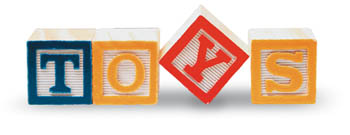 In addition to delivering the stuffed animals after the show, Cal Ostlund sent a follow-up letter thanking participants for their valuable stuffing time, along with a framed photo of exhibit staffers sitting in the booth surrounded by all the stuffed critters that had been created over the course of the show. In addition to delivering the stuffed animals after the show, Cal Ostlund sent a follow-up letter thanking participants for their valuable stuffing time, along with a framed photo of exhibit staffers sitting in the booth surrounded by all the stuffed critters that had been created over the course of the show.
When all was said and done, the inventive activity not only lured 95 out of 210 mailer recipients to the exhibit (a whopping 45-percent return), but it also fostered easygoing yet meaningful in-booth conversations that were anything but stuffy.
Caterpillars in the Park
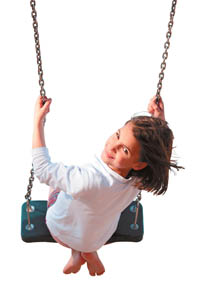 For Peoria, IL-based Caterpillar Inc., philanthropy wasn't an ancillary activity or afterthought in its exhibit. Rather, the booth itself was the company's philanthropic endeavor at ConExpo-Con/Agg 2011 in Las Vegas. Dubbed Generations Park, the 20,000-square-foot exhibit featured trees, bushes, park benches, etc., 98 percent of which was donated to local charities following the show. For Peoria, IL-based Caterpillar Inc., philanthropy wasn't an ancillary activity or afterthought in its exhibit. Rather, the booth itself was the company's philanthropic endeavor at ConExpo-Con/Agg 2011 in Las Vegas. Dubbed Generations Park, the 20,000-square-foot exhibit featured trees, bushes, park benches, etc., 98 percent of which was donated to local charities following the show.
"A core component of our company's mission deals with sustainable development," says J. Archie Lyons, IV, global brand marketing creative director at Caterpillar. "This means we strive to use technology and innovation to increase efficiency and productivity in our products and to create the least amount of impact on the environment." Thus, Generations Park, a lush, park-like setting comprising 20,000 square feet outside of the Las Vegas Convention Center, was created to highlight the company's commitment to sustainable development. "We wanted to demonstrate that we build machines that are environmentally friendly, have a solid economic return, and support the communities in which they work every day," Lyons says.
As visitors entered the park, built by Las Vegas-based Sun City Landscapes Inc. and Global Experience Specialists Inc., they encountered signage explaining that basically everything they saw inside the park would be donated to charity following the event. Specifically, paving blocks and concrete products loaned by the Pavestone Co. of Las Vegas would be returned to the company for reuse or recycling; meanwhile, all other materials were to be donated to the Boys & Girls Clubs of Las Vegas and to Opportunity Village, an organization that provides vocational training, employment services, and social experiences to those with intellectual disabilities.
Inside the park, attendees discovered the newest and oldest products in the Caterpillar line displayed in an idyllic setting. For example, the very first Cat machine, the Expo Twenty Tractor (originally manufactured in 1927), was positioned atop a small mound of aggregate surrounded by shrubs and grass. Meanwhile, a Cat CT660 Work Truck, a 21st-century vocational truck introduced at ConExpo/Con-Agg 2011, was nearby in a similarly peaceful setting. Signage near the equipment offered product specs and info about the equipment's earth-friendly benefits.
Visitors wound their way through the tree-lined park atop seemingly permanent pavestones similar to what you might find at an amusement park, while thoughtfully placed benches offered ample opportunities to rest amid the machinery. Canopies provided shade and highlighted key pieces of equipment throughout the park.
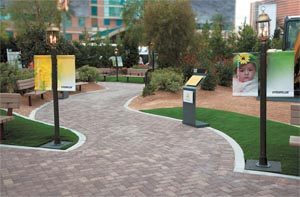 Amid the trade show's traditional displays featuring little more than monster machinery and a bit of graphics, Generations Park was no doubt a standout. In fact, it attracted more traffic than Caterpillar had anticipated, and became a huge hit with the media, which quickly picked up on its philanthropic angle. "In planning this exhibit, we knew we wanted something that would target the media and get journalists to not only visit our exhibit but write about it in the trade press," Lyons says. "Generations Park clearly won over the media. A conservative estimate shows that it generated more than 5 million media impressions via more than 70 stories and mentions after the show in print, on-line, and broadcast media." Amid the trade show's traditional displays featuring little more than monster machinery and a bit of graphics, Generations Park was no doubt a standout. In fact, it attracted more traffic than Caterpillar had anticipated, and became a huge hit with the media, which quickly picked up on its philanthropic angle. "In planning this exhibit, we knew we wanted something that would target the media and get journalists to not only visit our exhibit but write about it in the trade press," Lyons says. "Generations Park clearly won over the media. A conservative estimate shows that it generated more than 5 million media impressions via more than 70 stories and mentions after the show in print, on-line, and broadcast media."
But perhaps most importantly for Caterpillar, the unforgettable park setting hammered home its sustainability message, and the post-show donation demonstrated that the company doesn't just talk the talk, it walks the walk, ultimately donating 337 trees and bushes, 33 benches and trash bins, two storage barns, and various sustainable materials to local Las Vegas charities.
Trade Show Heroics
Elements Exhibits LLC understands just how devastating leukemia can be, as the North Las Vegas, NV-based firm lost its president, Tim Provo, to the disease. So to raise money for the Leukemia & Lymphoma Society (LLS) while at the same time increasing awareness of and generating new RFPs for its company, Elements created a "Be a Trade Show Superhero" theme for its exhibit at EXHIBITOR2011. Featuring comic-book-style villains and a philanthropic in-booth activity to donate money to the charity, the strategy created an atmosphere in which attending exhibit managers felt like true trade show superheroes.
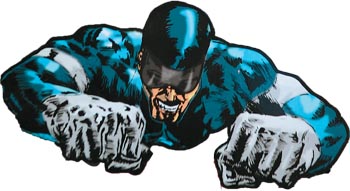 To kick off the theme, Elements sent attendees a pre-show mailer inviting them to visit the company's booth and learn how Elements could help them overcome their exhibiting
challenges. Once opened, the bi-fold mailer played foreboding music (think the-Joker-ponders-his-next-move mood music), which made for a truly memo-rable experience. To kick off the theme, Elements sent attendees a pre-show mailer inviting them to visit the company's booth and learn how Elements could help them overcome their exhibiting
challenges. Once opened, the bi-fold mailer played foreboding music (think the-Joker-ponders-his-next-move mood music), which made for a truly memo-rable experience.
At the 20-by-30-foot booth, visitors discovered an evil lair with fake rats peeking out of various locations and rusted barrels seemingly dripping with ooze. Dented warehouse-like lights hung from large metal I-beams throughout the space, while faux bricks and a rotating exhaust fan added to the industrial effect.
Near the front of the booth space, a large superhero graphic offered instructions for how to interact with the exhibit. Elements staffers dressed in befitting attire (women wore blue wigs, black masks, and capes; men wore Clark Kent-inspired outfits)
instructed attendees to pick up a game card and visit five different villains placed throughout the exhibit. Represented by life-size, comic-book-style graphics scattered about the space, the villains included Designer Dread, notorious for archaic designs; Dr. Drayage and his illicit service providers, who are overpriced and hard to work with; Rachel the Rebellious, who wields bad service like a death ray; Over Budget Boy, who breaks budgets like skulls; and Betty Bomb, who plans poorly executed events.
At each villain station, attendees watched a short video, which explained the villain and how Elements could make him or her go away for good, and then received a "defeat" code. Upon filling in each of the five defeat codes on their game cards, attendees discovered the word "Provo" - and staffers explained that the company had recently lost its president to leukemia. They invited attendees to help make a donation to LLS, a process that involved stepping onto a throwing platform and taking down the main, live villain, positioned inside a dunk tank.
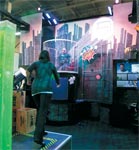 Atop the throwing platform, attendees turned in their cards in exchange for three beanbags to try and hit a target mechanism that when struck, dropped the villian into the dunk tank. Precariously positioned over the water, the villain - dressed in a wetsuit airbrushed with bulging muscles - heckled attendees waiting to take their shot. Undeterred, participants eagerly tossed their beanbags at the target arm. Atop the throwing platform, attendees turned in their cards in exchange for three beanbags to try and hit a target mechanism that when struck, dropped the villian into the dunk tank. Precariously positioned over the water, the villain - dressed in a wetsuit airbrushed with bulging muscles - heckled attendees waiting to take their shot. Undeterred, participants eagerly tossed their beanbags at the target arm.
"We knew the dunk tank would be fun and unique," says Alicia Rosen, Elements' general manager. "What we didn't anticipate was that attendees were so intent on dunking him that they often brought their friends back to the booth to have them give it a try, too." For every attendee that dunked the villain, Elements made a donation to LLS - $10 per dunk on day one, $20 on day two, and $40 on day three of EXHIBITOR2011.
At show's end, Elements had collected 225 leads, 75 more than its original goal. The superhero strategy also generated show-wide attention as throngs of attendees stopped by to see what all the yelling and splashing was about. Following the show, Elements made a $3,500 donation to LLS based on attendees' successful dunks.
Lending a Hand
Dealing with diabetes can be an incredibly isolating experience. So to help alleviate some of that loneliness, generate awareness for the disease, and unite the community of people dealing with it, LifeScan Inc. - the Milpitas, CA, maker of OneTouch blood-glucose measurement technology - launched The Global Diabetes Handprint initiative. Inspired by The Word in Your Hand Project (originally created by www.Tudiabetes.com), LifeScan's ongoing web-based initiative has also been a traffic-building activity within several of the company's exhibits.
 The Global Diabetes Handprint initiative is based on a simple yet meaningful activity. Those touched by diabetes write a word on one of their hands that expresses their feelings about the disease. They then take a picture of their hand and upload the photo and a brief description of their feelings at www.diabeteshandprint.com. Owned by LifeScan, the site currently features thousands of hand images and the stories behind them, thereby creating a global community that puts a human face on diabetes and makes all those dealing with the disease feel a little less alone. The Global Diabetes Handprint initiative is based on a simple yet meaningful activity. Those touched by diabetes write a word on one of their hands that expresses their feelings about the disease. They then take a picture of their hand and upload the photo and a brief description of their feelings at www.diabeteshandprint.com. Owned by LifeScan, the site currently features thousands of hand images and the stories behind them, thereby creating a global community that puts a human face on diabetes and makes all those dealing with the disease feel a little less alone.
What's more,for every hand photo uploaded to the website, LifeScan donates $5 to one of three diabetes charities: Taking Control of Your Diabetes, Diabetes Education and Camping Association, or Diabetes Hands Foundation. (After uploading their hand photo to the site, participants can specify to which charity they'd like their donation to be given.)
So to generate awareness for the initiative and drive traffic to its exhibit, LifeScan typically devotes about one-quarter of its 20-by-20-foot booth space to its Global Diabetes Handprint initiative at trade shows such as the 2011 Friends For Life event in Lake Buena Vista, FL. Shortly before the 2011 show, then, LifeScan crafted a pre-show mailer and show-bag insert, both of which comprised simple postcards inviting recipients to visit the booth and make their own hand-photo donation.
Arriving at the 400-square-foot booth, attendees found two tables and all the necessary accoutrements to decorate their hands and make their own hand photos, i.e., water-soluble markers, hand wipes, and two computers. Staffers encouraged a steady stream of attendees to step up to the desk, write a word relating
to their diabetes experience on their hand, add some decorative art, and then take a picture of it with one of the camera-enabled computers. Next, attendees used the same computer to visit the initiative's website and upload their hand photos and personal messages. Following the activity, staffers provided hand wipes to those who wanted to remove their messages and directed everyone to the OneTouch demonstrations located throughout the remainder of the booth space.
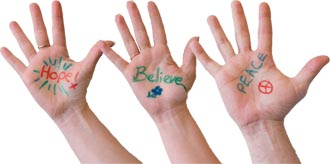 "Not only did the activity generate goodwill with families dealing with diabetes, but it drew quite a crowd to the exhibit as well," says Kim Burkus, account director at Jack Morton Exhibits, the Robbinsville, NJ-based agency responsible for incorporating LifeScan's initiative into its booths. "Not only did the activity generate goodwill with families dealing with diabetes, but it drew quite a crowd to the exhibit as well," says Kim Burkus, account director at Jack Morton Exhibits, the Robbinsville, NJ-based agency responsible for incorporating LifeScan's initiative into its booths.
"Throughout the three-day show, we had a constant line of people waiting to decorate and take photos of their hands - and to generate a donation from LifeScan to one of the three diabetes charities."
After the show, LifeScan created mini-upload kits to continue the activity. Featuring a branded box filled with hand-photo necessities - a branded table throw, markers, wipes, etc. - the kit allowed sales reps to bring the experience to local events to facilitate more photos and uploads. To date, the initiative's website has collected 8,700 photos, marking a total of $60,000 in donations to the three charities - not to mention increased awareness for LifeScan.
The Quilting Bee
Nothing soothes the soul like a good snuggle in a handmade quilt. That's why Allos Therapeutics Inc., a Westminster, CO, biopharmaceutical company specializing in anti-cancer therapeutics, crafted its philanthropic, in-booth activity around a quilt donation to cancer patients. Launched at the American Society of Clinical Oncology (ASCO) show several years back - and used at subsequent trade shows thereafter - the quilting activity was intended to draw attention to Allos, a newcomer to the oncology market at the time.
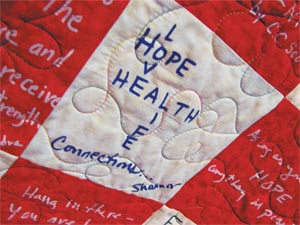 Going into ASCO, Allos wanted to bypass traditional giveaways in favor of something a little different. That's because most pharmaceutical exhibitors (Allos included) must abide by various health-care regulations that, among other things, regulate the distribution of giveaways at medical conventions. And as such, exhibitors typically give out education-related items, which while admissible under the regulations are often forgettable back at physicians' offices. Going into ASCO, Allos wanted to bypass traditional giveaways in favor of something a little different. That's because most pharmaceutical exhibitors (Allos included) must abide by various health-care regulations that, among other things, regulate the distribution of giveaways at medical conventions. And as such, exhibitors typically give out education-related items, which while admissible under the regulations are often forgettable back at physicians' offices.
So rather than give attendees another educational tchotchke, Allos teamed up with Impact Unlimited, a Dayton, NJ-based integrated-marketing company, to offer them a quilt-making activity instead. "Attendees get more value and exhibitors generate more awareness and memorability from in-booth activities than from any kind of giveaway," says Sandie Stransky, vice president of sales at Impact Unlimited. The team hoped the quilting concept would not only generate attention at the show, but also stitch the Allos name into attendees' memories.
As attendees approached the company's 20-by-30-foot booth, their eyes were drawn to a roughly 25-foot-long wall covered in quilting squares featuring Allos' corporate red and white hues. Two completed quilts adorned the right and left sections of the back wall. Each quilt held 35 squares, 31 of which featured messages of hope and employee signatures; meanwhile, the four corner squares each offered a single, embroidered word, such as "Optimism" or "Strength."
Graphics across the top of the wall read "Aspire Life Love Optimism Strength" - with the first letter of each word spelling out Allos in red text. Immediately below the graphic, Allos positioned four digital photo frames, each one of which depicted photos of its employees writing on the squares and constructing the quilts.
At a reception desk in front of the wall, a staffer scanned attendees' badges and encouraged them to select a white or red fabric "Square of Strength," write his or her own message of encouragement on the square, and sign the bottom. The staffer then informed participants that after the show, Allos would sew the completed squares into as many quilts as possible, each one of which would be donated to a cancer center for distribution to patients. Poster boards positioned in front of the wall also explained the quilt-donation process.
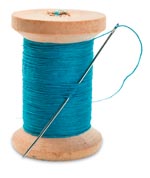
Eager to support cancer patients, attendees happily completed the activity - adding messages such as "Life is a gift!" and "May hope, faith, and courage be your guiding light today and always." A staffer then attached completed squares to the center of the back wall, where they formed a red and white checkerboard pattern. The staffer then encouraged attendees to read the messages on the quilts and recently completed Squares of Strength on the back wall - and to explore the rest of the booth, which explained Allos' commitment to anti-cancer therapeutics.
While Allos hoped that the activity would draw 465 attendees into the exhibit (ultimately creating awareness for the company and its offerings), it attracted 682 participants, which was enough to create 22 quilts, 32 percent more than Allos' pre-show goal. E
|




 oing something good - be it for the environment, a sick kid, or an entire neighborhood - can certainly generate oodles of warm fuzzies. But according to the Cone Cause Evolution Study, sponsored by communications agency Cone LLC, doing good for others can also generate cold hard results for corporations.
oing something good - be it for the environment, a sick kid, or an entire neighborhood - can certainly generate oodles of warm fuzzies. But according to the Cone Cause Evolution Study, sponsored by communications agency Cone LLC, doing good for others can also generate cold hard results for corporations. 


 In addition to delivering the stuffed animals after the show, Cal Ostlund sent a follow-up letter thanking participants for their valuable stuffing time, along with a framed photo of exhibit staffers sitting in the booth surrounded by all the stuffed critters that had been created over the course of the show.
In addition to delivering the stuffed animals after the show, Cal Ostlund sent a follow-up letter thanking participants for their valuable stuffing time, along with a framed photo of exhibit staffers sitting in the booth surrounded by all the stuffed critters that had been created over the course of the show.  For Peoria, IL-based Caterpillar Inc., philanthropy wasn't an ancillary activity or afterthought in its exhibit. Rather, the booth itself was the company's philanthropic endeavor at ConExpo-Con/Agg 2011 in Las Vegas. Dubbed Generations Park, the 20,000-square-foot exhibit featured trees, bushes, park benches, etc., 98 percent of which was donated to local charities following the show.
For Peoria, IL-based Caterpillar Inc., philanthropy wasn't an ancillary activity or afterthought in its exhibit. Rather, the booth itself was the company's philanthropic endeavor at ConExpo-Con/Agg 2011 in Las Vegas. Dubbed Generations Park, the 20,000-square-foot exhibit featured trees, bushes, park benches, etc., 98 percent of which was donated to local charities following the show.


 The Global Diabetes Handprint initiative is based on a simple yet meaningful activity. Those touched by diabetes write a word on one of their hands that expresses their feelings about the disease. They then take a picture of their hand and upload the photo and a brief description of their feelings at www.diabeteshandprint.com. Owned by LifeScan, the site currently features thousands of hand images and the stories behind them, thereby creating a global community that puts a human face on diabetes and makes all those dealing with the disease feel a little less alone.
The Global Diabetes Handprint initiative is based on a simple yet meaningful activity. Those touched by diabetes write a word on one of their hands that expresses their feelings about the disease. They then take a picture of their hand and upload the photo and a brief description of their feelings at www.diabeteshandprint.com. Owned by LifeScan, the site currently features thousands of hand images and the stories behind them, thereby creating a global community that puts a human face on diabetes and makes all those dealing with the disease feel a little less alone.





